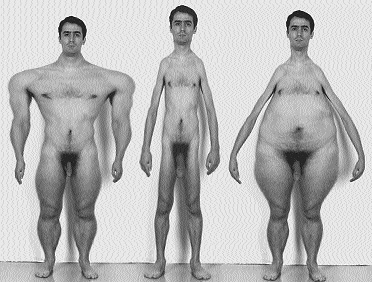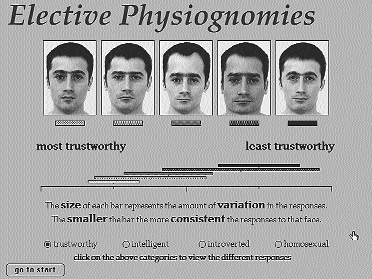John Tonkin: man or morph?
Vicki Sowry reviews Elective Physiognomies and Elastic Masculinities

John Tonkin, Elastic Masculinities
Using his body as a template, Sydney-based new media artist John Tonkin has created a corpus of static faces and morphing bodies which the viewer/user is invited to adjust, tweak and—ultimately—pass judgment upon.
Tonkin developed an interest in pseudo-sciences relating specifically to the body after viewing an exhibition of physiognomic drawings and artefacts in 1992. He was particularly interested in how such theories could interplay with emergent morphing technologies.
Elective Physiognomies and Elastic Masculinities are the outcomes of Tonkin’s exploration into ideas relating to the face and body as sites of identity, in particular, identity which can be culturally mapped through the employment of ‘scientific’ modalities. Both works were recently shown at The Performance Space and at the Cyber Cultures exhibition at the Casula Powerhouse.

John Tonkin, Elective Physiognomies
Elective Physiognomies comprises an interactive, authored in Hypercard, and a series of printouts of digitally manipulated faces and fictional DNA code. The interactive invites the user to prioritise a number of these faces (which use the artist’s face as starting point, or source code if you like) according to criteria including most-to-least trustworthy, most-to-least intelligent, most-to-least homosexual. The interactive then tabulates the user’s response against the combined average of all previous user responses to ascertain the consistency of response to each face.
For Tonkin, this statistical component, while interesting, is not as important as the creation of an interactive structure which, through the user’s navigation, gives rise to the ideas and themes of the piece. In this manner the task structure of Elective Physiognomies insists upon the disturbing outcome of codifying faciality to such levels of rigidity and generalisation.
Tonkin takes this notion further in his most recent work, Elastic Masculinities. Here, the artist uses his full body as a point of departure to question the perceived alignment of masculine attributes with particular body shapes. Similar to Elective Physiognomies, the piece comprises a series of printouts of fictional bodies alongside a Java-authored interactive. The user is invited to adjust the dimensions (height, chest, hips, etc) of a randomly generated body and is then asked to classify the constructed body according to sliding criteria which includes gentle/forceful, graceful/awkward, masculine/feminine.
Elastic Masculinities is currently at beta stage; future versions of the work are intended to provide the user with an image of the statistically average body (again using tabulations of previous user responses) for each chosen position along the sliding criteria. In doing so, Tonkin hopes to prompt the user to question the validity of systematisation in such diffuse areas as gender and subjectivity.
The next piece in Tonkin’s evolving body of work will investigate eugenics and genetic modelling as they relate to morphing technologies. Currently in development, the work stems from the artist’s response to a perception that biological metaphors and allied evolutionary navigational systems are on the increase.
For further reference, the 1996 Ars Electronica network symposium—Memesis: The Future of Evolution—is particularly useful: www.aec.at/meme/symp [expired].
John Tonkin, Cyber Cultures, Casula Powerhouse, March 9-April 6
RealTime issue #18 April-May 1997 pg. 23






